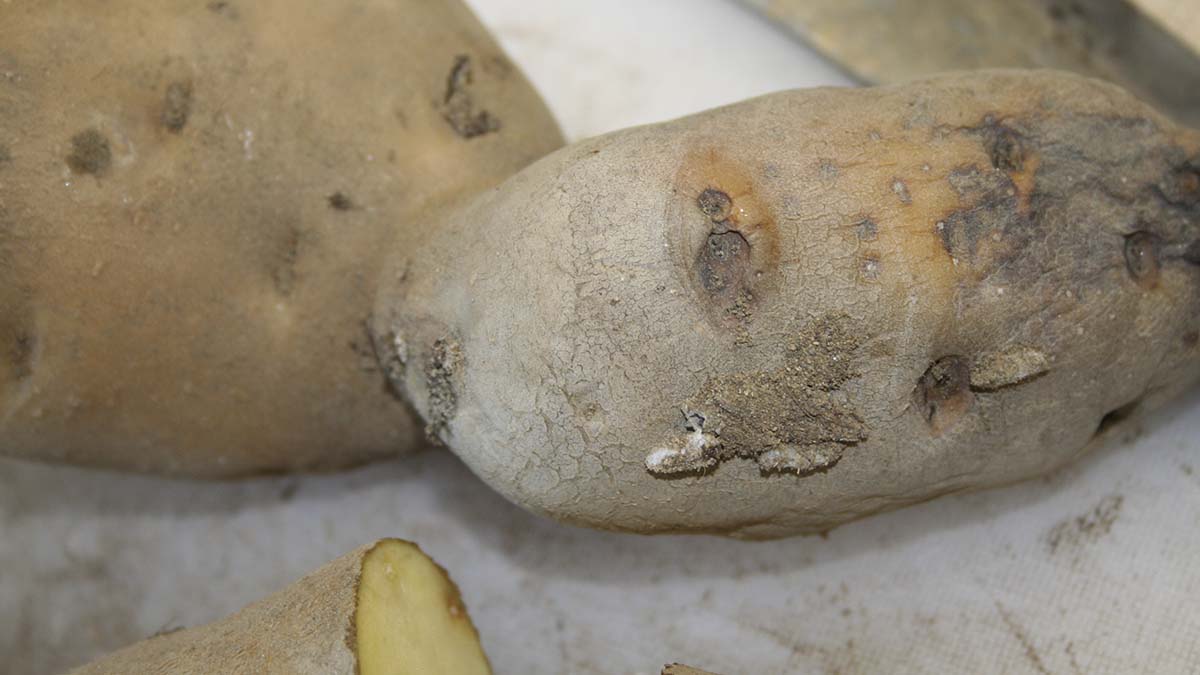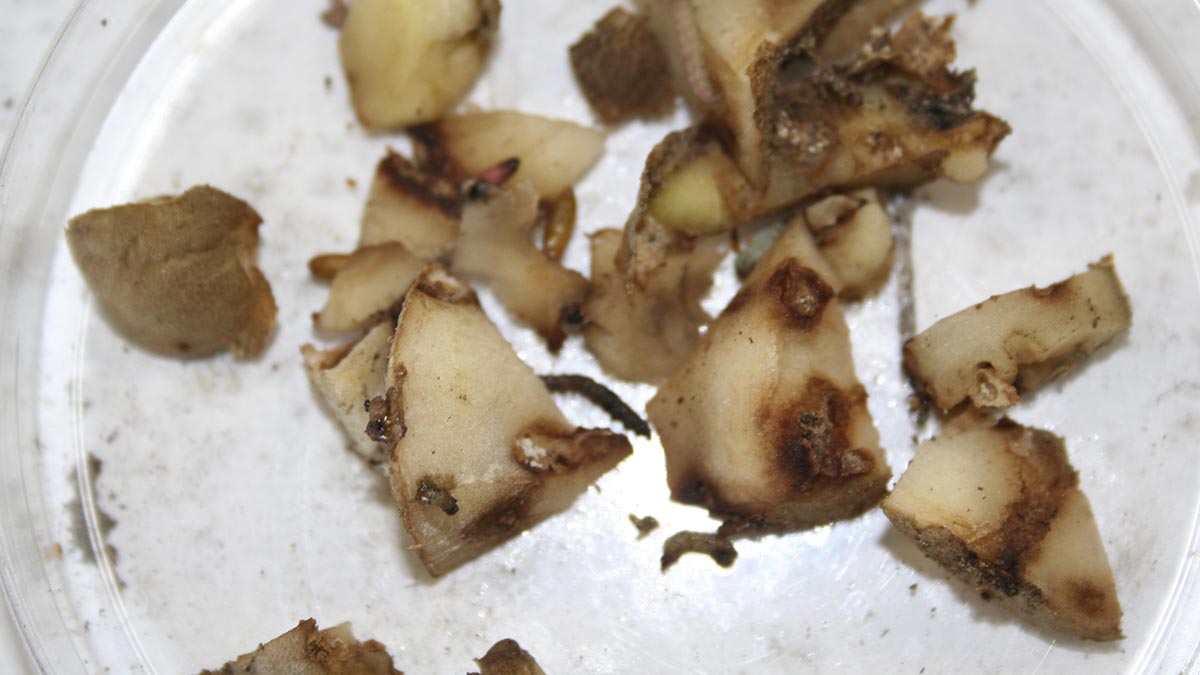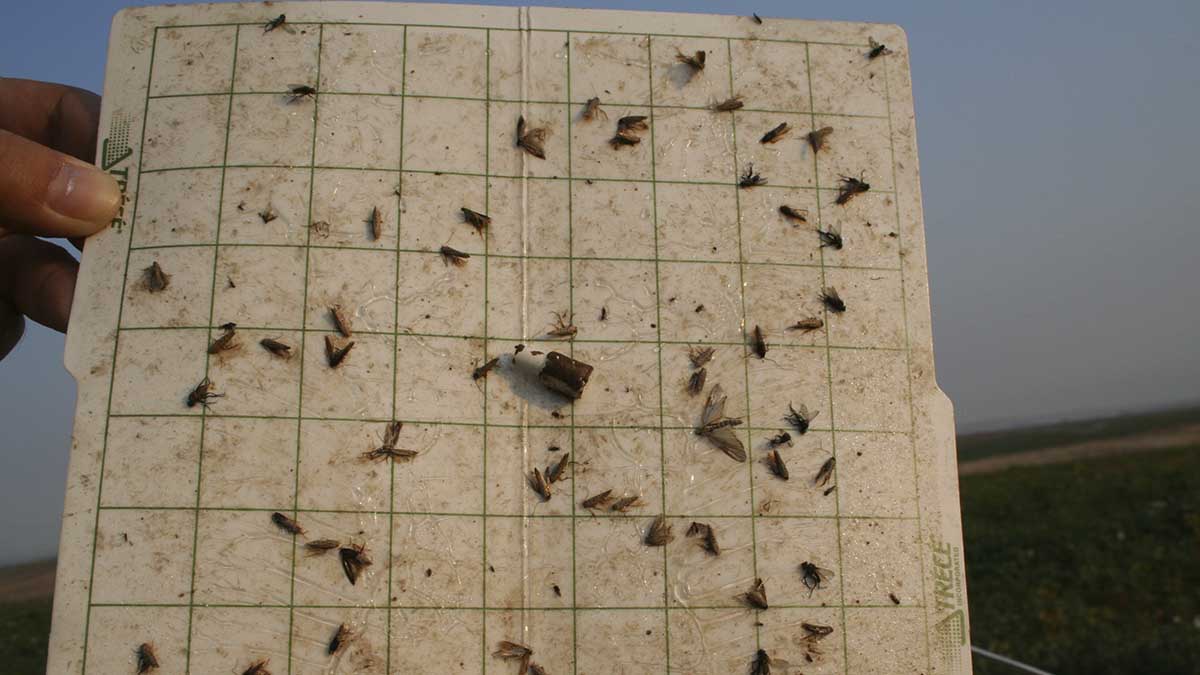Potato Tuberworm
Pest Common Name
- Potato Tuberworm or Potato Tubermoth (Phthorimaea operculella)
- Potato, tomato and other plants in the family Solanaceae
The adult potato tuberworm is a silver-gray to brown-gray moth, with darker gray-brown or black markings in the family Gelechiidae (Figure 1). Adults are approximately 3/8 in (9.5 mm) long and narrow bodied when their wings are tucked in, with a 1/2 in (13 mm) wingspan. Wings have fringed edges, and their characteristic patterns (two or three dots running longitudinally on males, or an “X” across the back of females) can be used to identify them.
Larvae (caterpillars) can take on various colors, from off-white or gray to pink or greenish depending on their life stage and what they feed on. When fully grown, larvae measure approximately 3/8 in (9.5 mm) in length and are usually light brown with a darker brown head, though larger larvae may take on a pink or green hue.
Eggs are tiny spheres, about 1/64 in (0.4 mm) in diameter, ranging in color from white to yellow to brown. Females primarily lay eggs primarily on foliage but also on exposed tubers or on the ground.
Both adults and larvae have many look-alikes, and identification may require close examination or assistance from extension personnel.

Biology
There may be three generations of potato tuberworm per year in Idaho, though continuous breeding can occur under the right conditions. Generation times can vary from as short as two weeks under warm, summer conditions, to as long as eight months when development is slowed by cold temperatures during winter.
A single adult female can lay up to 200 eggs in her lifetime. Eggs are primarily laid on stems and undersides of leaves of potato plants but will occasionally also be laid on eyes of tubers. About five days after they are laid, eggs hatch into larvae (caterpillars). Larvae feed for up to two weeks before they drop to the soil and pupate. Pupation occurs in silk cocoons and takes about 10 to 30 days. Adults live for one to two weeks after emergence, during which time they can be seen mostly at dawn and dusk.
Damage
Potato tuberworm larvae feed on leaves, preferring the leaves in the upper canopy. Larvae feed by tunneling (or “mining”) leaf tissue between the upper and lower layers of the leaf epidermis. This damage can be hard to see without close inspection. Potato tuberworm prefers to feed on foliage, but when foliage begins to senesce or during vine kill, they may drop to the soil and feed on tubers. Larvae may also feed on tubers in storage, where they can spread from infested to uninfested tubers, and potentially destroy an entire crop of stored tubers. Larvae burrow into tubers, leaving tunnels filled with frass (excrement) (Figures 2 & 3). Feeding on tubers is much more economically impactful than feeding on foliage.
Monitoring
In areas potentially impacted by potato tuberworm, monitor insect numbers using pheromone traps. Deploy at least one trap per potato field immediately after canopy closure. Check traps weekly and replace lures monthly.
There are no established economic thresholds for potato tuberworm, but the University of California recommends a threshold of 15-20 moths per trap per night and Oregon State University recommends treatment if eight moths per trap per day are captured (Figure 4).



Management
Primary Management Tactics
Cultural management tactics are key for potato tuberworm. Prompt harvesting after vine kill, and ensuring tubers remain covered by at least 2 inches (6 cm) of soil via selection of deep setting varieties, hilling and/or preventing soil cracking are recommended.
Cultural
- Consider varieties with deep tuber setting, as shallow-set tubers are more susceptible to damage
- Minimize time between vine kill and harvest as the longer tubers remain in the field after vine kill the more likely potato tuberworm damage becomes
- Remove cull piles and volunteer potato plants that can host potato tuberworm
Biological
- Nematodes such as Hexamermis, Steinerma and Heterorhabditis may help control potato tuberworm, when under favorable conditions (e.g., high humidity, low solar incidence)
- Beauveria bassiana and baculoviruses may help control potato tuberworm, when under favorable conditions (e.g., high humidity, low solar incidence)
Chemical
- Application of insecticides at or just before vine kill can reduce potato tuberworm populations that would otherwise begin feeding on tubers
- Incorporating essential oils into a conventional pesticide program may improve control
- Recommendations for pesticides to use in the management of potato tuberworm can be found on the PNW Pest Management Handbooks website
Further reading
Pesticide Warning
Always read and follow the instructions printed on the pesticide label. The pesticide recommendations in this University of Idaho webpage do not substitute for instructions on the label. Pesticide laws and labels change frequently and may have changed since this publication was written. Some pesticides may have been withdrawn or had certain uses prohibited. Use pesticides with care. Do not use a pesticide unless the specific plant, animal or other application site is specifically listed on the label. Store pesticides in their original containers and keep them out of the reach of children, pets and livestock.
Trade Names — To simplify information, trade names have been used. No endorsement of named products is intended nor is criticism implied of similar products not mentioned.
Groundwater — To protect groundwater, when there is a choice of pesticides, the applicator should use the product least likely to leach.
- Figure 1. James Hayden, Microlepidoptera on Solanaceae, USDA APHIS PPQ, Bugwood.org
- Figures 2-4. Rondon, Oregon State University, Irrigated Agricultural Entomology Program
Desiree Wickwar, Entomologist, IPM Project Manager
Erik J. Wenninger, Professor of Entomology, IPM Coordinator
2023










